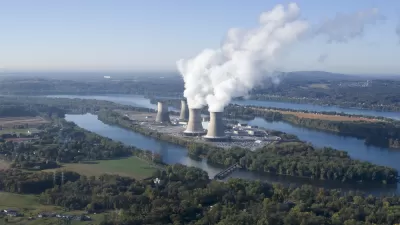The rise is attributed to Asian nations, particularly India and China, where coal-power plants are newer than in the West. It shows a growing disconnect between energy and climate goals, warned the International Energy Agency.

"Fatih Birol, head of the International Energy Agency (IEA), said the growth of coal-fired power in Asia was worrying because the new plants would 'lock in the emissions trajectory of the world, full stop',” report Leslie Hook, David Sheppard and Myles McCormick. The average age of Asian coal plants is 11 years, compared to Western coal plants averaging 42 years. Worse yet, despite being newer, many are less efficient than those used in Europe and the U.S.
“How we are going to deal with this problem is for me the nerve centre of the climate change debate today,” Mr Birol told the Financial Times, adding that the data on energy consumption is moving in “close to the opposite direction” of climate targets.
Energy-related carbon dioxide emissions ticked up 1.4 per cent last year, following several years of staying flat, and are set to rise again in 2018 owing to greater demand for fossil fuels. Asia accounted for two-thirds of the growth in emissions last year.
By contrast, emissions decreased last year in the U.S. by 2.7 percent, largely due to a 4.5 percent decrease in power plant emissions as coal-burning plants shuttered.
Last year China’s coal-fired power generation grew 4 per cent, while India’s rose 13 per cent, according to IEA data. The rate of investment in the construction of new coal-fired power plants, however, also slowed down last year, according to the agency.
Mr Birol said the Asian coal plants were a crucial reason why renewable energy consumption and carbon dioxide emissions were both increasing at the same time. “It’s one of the blind spots of the climate change discussion,” he said.
BP's "Statistical Review of World Energy," released in June, confirms the IEA data.
"The opening of new coal-fired power plants in India and China drove coal consumption higher by 1 percent, highlighting the difficulties developing economies face in meeting demand for electricity while fighting pollution," reported Ron Bousso for Reuters on June 13 on the BP report [pdf].
Page 13 lists coal consumption by country. China's consumption peaked in 2013 and dropped every year until 2017. [Also see "related" posts below.] India, on the other hand, has increased consumption every year since 2007.
[T]he share of [global] coal in power generation today remains around 38 percent, practically unchanged since 1997, while the share of non-fossil fuels slightly dipped as nuclear power capacity shrunk, BP Chief Economist Spencer Dale said.
“This is really worrying,” Dale told reporters in a briefing before the report was released. “How much progress have we made in 20 years? None.”
A final grim note: Feng Hao of China Dialog reports that "CoalSwarm published a report [pdf] on September 26 warning that 259 gigawatts of coal power capacity – equivalent to the entire coal power fleet of the United States – is being built in China despite government policies restricting new builds."
Related in Planetizen:
-
China Cancels 103 Coal Power Plants; Still Has Too Much Coal Capacity, January 20, 2017.
-
China Cutting Carbon, October 1, 2016: China’s coal use and carbon emissions have dropped for the last two years.
-
Peak Coal: China's Carbon Emissions Drop as the Use of Coal Slows, August 10, 2016: China's use of coal peaked in 2014.
FULL STORY: New Asian coal plants knock climate goals off course

Alabama: Trump Terminates Settlements for Black Communities Harmed By Raw Sewage
Trump deemed the landmark civil rights agreement “illegal DEI and environmental justice policy.”

Planetizen Federal Action Tracker
A weekly monitor of how Trump’s orders and actions are impacting planners and planning in America.

The 120 Year Old Tiny Home Villages That Sheltered San Francisco’s Earthquake Refugees
More than a century ago, San Francisco mobilized to house thousands of residents displaced by the 1906 earthquake. Could their strategy offer a model for the present?

In Both Crashes and Crime, Public Transportation is Far Safer than Driving
Contrary to popular assumptions, public transportation has far lower crash and crime rates than automobile travel. For safer communities, improve and encourage transit travel.

Report: Zoning Reforms Should Complement Nashville’s Ambitious Transit Plan
Without reform, restrictive zoning codes will limit the impact of the city’s planned transit expansion and could exclude some of the residents who depend on transit the most.

Judge Orders Release of Frozen IRA, IIJA Funding
The decision is a victory for environmental groups who charged that freezing funds for critical infrastructure and disaster response programs caused “real and irreparable harm” to communities.
Urban Design for Planners 1: Software Tools
This six-course series explores essential urban design concepts using open source software and equips planners with the tools they need to participate fully in the urban design process.
Planning for Universal Design
Learn the tools for implementing Universal Design in planning regulations.
Clanton & Associates, Inc.
Jessamine County Fiscal Court
Institute for Housing and Urban Development Studies (IHS)
City of Grandview
Harvard GSD Executive Education
Toledo-Lucas County Plan Commissions
Salt Lake City
NYU Wagner Graduate School of Public Service





























